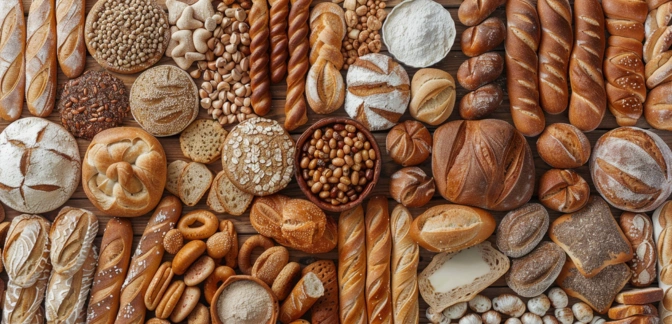Graham Bread — Nutrients, Health Benefits, And Shopping Tips

Written by Listonic Team
Last update on September 4, 2024
Nutrition facts
Nutrition facts
Amount per 100 g
Calories
🔥 253 kcal
| Nutrition per: 100 g | Value | % Daily Value* |
|---|---|---|
| Carbs | 47 g | 17.09% |
| Fiber | 7 g | 25% |
| Sugars | 8 g | 16% |
| Glycemic Index | 55 | - |
| Protein | 10 g | 20% |
| Sodium | 524 mg | 22.78% |
| Total Fat | 4 g | 5.13% |
*The % of Daily Value (DV) tells you how much a nutrient in a serving of food contributes to a daily diet. 2,000 calories a day is used for general nutrition advice.
10 g
🧀 Good Protein Content
7 g
🥔 Good Fiber Content
Did you know?
Health benefits
- High in fiber, promoting digestive health, regular bowel movements, and a healthy gut microbiome.
- Provides sustained energy from complex carbohydrates, making it a good source of fuel for the body and brain.
- Rich in essential vitamins and minerals such as B vitamins, iron, and magnesium, which support overall health and well-being.
- Supports heart health by helping to lower cholesterol levels and reduce the risk of cardiovascular disease.
- May aid in weight management by promoting satiety and reducing overall calorie intake.
Health risks
- High carbohydrate content which can cause rapid spikes in blood sugar levels, particularly concerning for diabetics or those on low-carb diets.
- Potential for high calorie content depending on the recipe, which can contribute to weight gain if consumed in large quantities or as part of a calorie-dense meal.
- Potential for added sugars in some recipes, which can contribute to weight gain, tooth decay, and increased risk of diabetes.
- Gluten content making it unsuitable for individuals with celiac disease or gluten sensitivity, potentially causing digestive discomfort and other health issues.
How to choose graham bread
Graham bread, made from whole wheat flour, should be dense yet soft, with a slightly sweet and nutty flavor. The bread should have a moist crumb and spring back lightly when pressed.
Pass over graham bread that is dry or stale, which can detract from its naturally rich flavor. Well-made graham bread should be hearty and satisfying, perfect for sandwiches or toasting.

How to store graham bread
Graham bread should be stored at room temperature in an airtight container or bread box. Keep it in a cool, dry place to maintain its freshness. Properly stored, graham bread can last up to a week.
Refrigeration can alter the texture of graham bread, making it stale faster. It’s important to keep it in a dry environment. Sealing it properly helps preserve its natural moisture and flavor.
✅ Extra Tip
How long does it last?
Graham bread can last for 3-5 days at room temperature when stored in an airtight container. For longer storage, graham bread can be frozen for up to 3 months. Ensure it is tightly wrapped to prevent freezer burn.
What to do with leftovers?
Leftover graham bread can be used in a variety of delicious ways. Slice it and use it for sandwiches, or toast it for a quick breakfast with butter and jam. Graham bread is also great when turned into French toast, where its slightly sweet flavor adds depth to the dish.
Use graham bread to make a bread pudding by soaking it in a custard mixture and baking until golden. If you have a lot of graham bread, consider making a batch of croutons for salads or soups, or using it as a base for a stuffing with herbs and vegetables. Graham bread can also be used in a grilled cheese sandwich, where its hearty texture complements the melted cheese. For a quick snack, toast graham bread slices and serve with peanut butter, honey, or a sprinkle of cinnamon.
👨⚕️️ Medical disclaimer
Discover products from other categories
Listonic Team
Fact-checked
Our editorial team checked this article to make sure it was accurate at the time of publishing it.
Get the top-rated shopping list app

graham bread
1 piece







